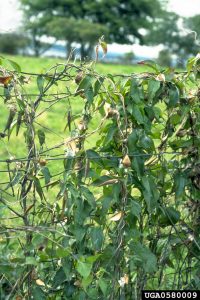Chapter 9: Weed Management Strategies
9.2 Weed Management Strategies – Prevention
As we begin to look into more detail at different options for managing weeds in field crop systems, we need to consider the broader goals or strategies. In general these fall under three categories: prevention, eradication and control.
1. Prevention

With prevention, the goal is to eliminate the weed problem before it starts. As discussed previously, invasive weeds need to be transported and introduced before they can establish and spread. Stopping them from being transported prevents the larger challenges later. The same concept is also true with non-invasive weeds; by preventing them from being spread into other fields, for example, farmers will save additional costs in later trying to reduce the weed impacts in a new field.
In order to be successful in preventing weed problems, it is crucial to think about how our actions might be unintentionally introducing different weed species into fields or in some manner contributing to the problem.
- Crop seed lots can contain weed seeds if not properly cleaned. Then during crop planting, weeds also get planted unintentionally. When growing a crop like wheat, where farmers might be saving seed to grow the next year, cleaning seed is particularly important.
- Weed seeds can be transported with straw and animal feed. This is important tokeep in mind when baling straw after harvesting a crop or when harvesting forages. If the field had weeds that went to seed, those weed seeds will now be in the straw/hay which is moved and used for animal needs. Many weed seeds can pass unharmed through animal digestive tracts. By keeping fields harvested for straw or animal feed free of weeds, the movement of weed seeds can be prevented.
- If you are working in an organic system or using manure for part of your fertilizer regimen, it is recommended that you allow the manure to compost or age for a year. This helps lower the amount of weed seeds that are able to germinate, thereby reducing the number of viable weed seeds introduced later when manure is spread onto the field.
- Harvesting and tillage equipment can unintentionally transport weed seeds. If you have a field with weeds that went to seed, those weed seeds will be spread in a greater area as they pass through the combine. Weed seeds can also blow out of trucks as the harvested grain is hauled to storage facilities, and contaminate neighboring fields. Tarping trucks can prevent this from happening. With tillage equipment, turning over the soil brings more weed seeds to the surface where they can germinate. In addition, if you are working in a heavily infested field and do not take the time to properly clean the equipment before moving to another field, you risk transporting weed seeds.
- Weeds can reestablish in fields from fence rows. This can be easy to overlook because the few weeds in the fence row may not seem significant. It is important to remember, though that whatever is growing in the ditches or along the fence row, will grow and reproduce. Those seeds can spread back into your field. It is especially important to keep an eye on that for any noxious weeds. Penn State University’s, Dr. Dave Mortensen is doing research to investigate this dynamic. To read more about Dr. Dave Mortensen, and his research, visit this link: https://plantscience.psu.edu/directory/dam37